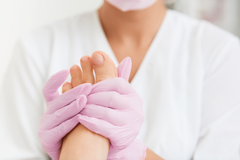Let’s Talk About Flat Feet

by Dr. Emily Splichal, DPM MS
Over 5,000 times a day the human foot is adjusting to the surfaces we walk on, absorbing potential energy from impact forces and propulsing us through each step we take.
What allows these basic movement functions to occur? Pronation.
What is Pronation?
Defined as an unlocking of the foot, pronation is a complex triplanar motion that involves the rearfoot and midfoot joints. It is typically associated with the rolling inward of the foot or what is called eversion and is coupled with a dropping of the arch.
This unlocking of the foot is what allows the foot to become a mobile adaptor and decelerator against impact forces. Despite the importance of pronation on foot function, like with most things, too much of a good thing can be bad.
Enter Over-Pronation also known as Flat Feet.

Over-pronation is when the degree of unlocking or eversion is beyond the range that is needed for absorbing impact forces.
Over-pronation can be associated with:
- Ligament laxity
- Foot muscle weakness
- Hip muscle weakness
- Limited ankle mobility
Symptoms of Over-Pronation
As the degree of foot pronation increases this can cause stress to the soft tissue structures of the foot, leading to plantar fasciitis, posterior tibial tendinitis, medial ankle pain and even contribute to bunions.

Due to the integrated function of the foot, over-pronation of the foot can also cause transfer stress up the lower extremity and to the pelvis.
It is not uncommon to find over-pronation associated with:
- Shin splints
- Knee pain
- Low back pain
- SI joint pain
Managing Overpronation

Depending on the cause of over-pronation the treatment recommendations may vary slightly, however some of the most common treatments include:
- Custom orthotics or arch supports
- Supportive footwear
- Foot and ankle mobility
- Foot and hip strengthening
In my personal podiatry office, regardless of the cause of the over-pronation all patients will get some sort of foot mobility exercises and a foot strengthening program. Due to the daily demands of the foot, I recommend integrating at least five minutes of a foot massage on a golf ball or Neuro Ball every morning and evening. In addition, focused foot strengthening such as standing on one leg, short foot exercise or Pilates are great ways to reconnect to our foot muscles.
If you think you may be over-pronating and want to have full foot evaluation, please see your local podiatrist.



Leave a comment